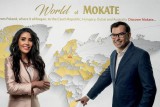“RFID is a technology of remote identification of objects using radio waves. Its origins date back to the 1960s, but it is currently undergoing a revival. It is applied in many sectors, from fashion retail to hospitals, logistics and all sorts of person and object identification systems,” Marek Kwiatkowski, the Director of the Digital Department at Sescom S.A., says to the Newseria Business Agency.
The RFID technology utilizes radio waves for the purpose of remote identification of persons and objects. Its basis of operation is simple: miniature devices, known as tags, chips or badges, containing an electronic circuit with coded data, are attached to objects. By using radio waves, we can read and code data from and to the tags. This can be done with portable or stationary equipment – readers or antennae.
The value of the global market related to the RFID technology is currently estimated at approx. $11 billion, whereas forecasts assume it will grow to as much as approx. $15 billion over the next five years. According to RFID Polska, the industry grows by approx. 25% per annum. About 30 million RFID chips are sold in Poland annually; 100 million are currently in common use.
“We are speaking of a really huge and dynamically growing market,” Marek Kwiatkowski emphasizes.
He stresses that RFID used to be a relatively expensive technology only several years ago, which made it hard to find economic benefits from its application. However, the RFID technology has become much cheaper over the recent years, simultaneously bringing measurable benefits to companies of different industries, which contributes to its quick diffusion.
“RFID has a very wide range of application: from identification of cars in parking lots or persons moving within buildings, to analysis of movement of goods in clothing stores,” Marek Kwiatkowski enumerates.
This technology has an almost unlimited scope of use in retail trade, e.g. in footwear or clothing stores. It enables ongoing monitoring of the stock, order at the store (the system tracks the distribution of goods on shelves and detects those lying in wrong places), reduces the time needed for inventory, and prevents theft, because when a product bearing a RFID radio tag disappears from its shelf, the system checks the data, verifies whether it has already been sold, and activates a discreet alarm if necessary. Such activities enable a 3-percent increase in sales for the entire trade chain.
Retailers and trade chains may also use RFID for advertising purposes. For instance, when a customer enters a fitting room at a clothing store, a chip located within the tag will send a signal to a reader located by the window and display a dedicated advertisement or visualization of a specific product. According to the data of the Accenture consulting company, referenced by Sescom, as much as 92% of retailers are already implementing RFID in the USA, along with approx. 70% in Asia and 30% of European commercial sector entrepreneurs.
Among other things, this technology can also be used to more expensive medicine in order to prevent counterfeiting. A chip in the packaging enables tracking of the medicine’s way from the manufacturer, through suppliers, up to the pharmacy, ensuring guarantee of origin. This is especially significant since – as shown by the WHO data – every hundredth preparation available on the market may be counterfeited, just as, on average, every second one offered on the Internet.
Technology based on radio waves allows companies to save time and money. For example, radio waves allow one person to inventory several thousand commodity units per hour. Without this technology, only 150–200 units per hour would be possible.
“In the future fashion retail sector, RFID will allow real-time automated management of trade chains – this is the future. With ongoing information of what is found at the store, what sells, how the commodity moves in this store, it will be able to make instant, conscious management decisions using artificial intelligence or data prediction systems,” Marek Kwiatkowski says.
The RFID technology may also become an answer to the change of purchasing habits of consumers. For example, the current standard in e-commerce is delivery of ordered goods within 24 hours. Due to growing customer expectations, most brands and retailers strive to reduce this time to a minimum. This exactly is made possible by the RFID technology.
“Today, performing a store inventory every couple of months, dealers do not really know the actual value of their store. Consequently, they are unable to deliver goods directly from the store to the end customer. RFID enables real-time stock analysis, making it possible to implement orders directly to the customer over a very short time,” the Sescom expert says.
Marek Kwiatkowski
Director of the Digital
Department at Sescom S.A.
Source: Newseria.pl












